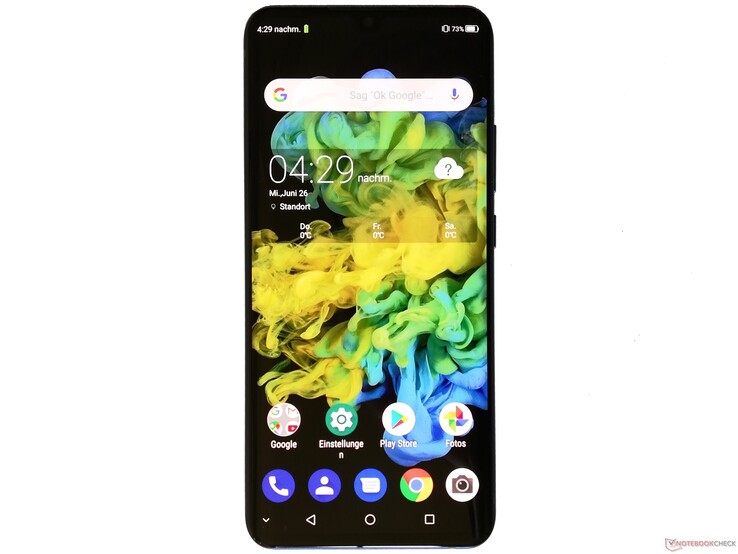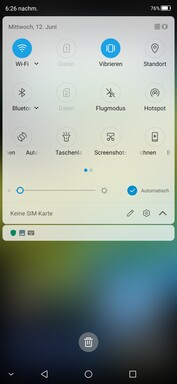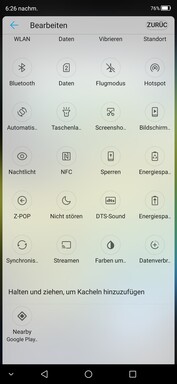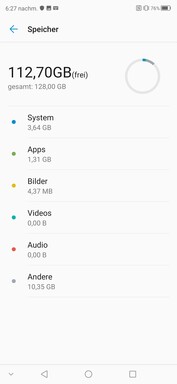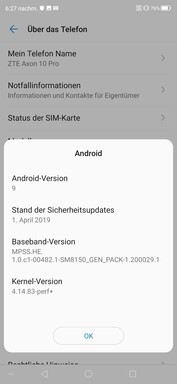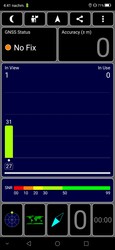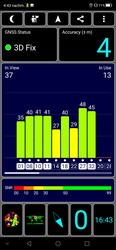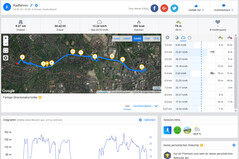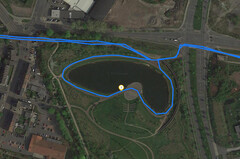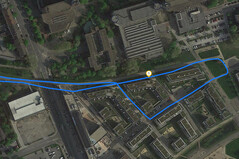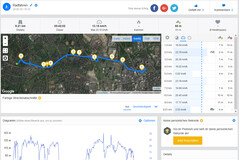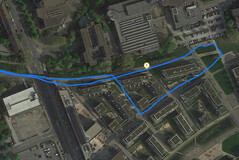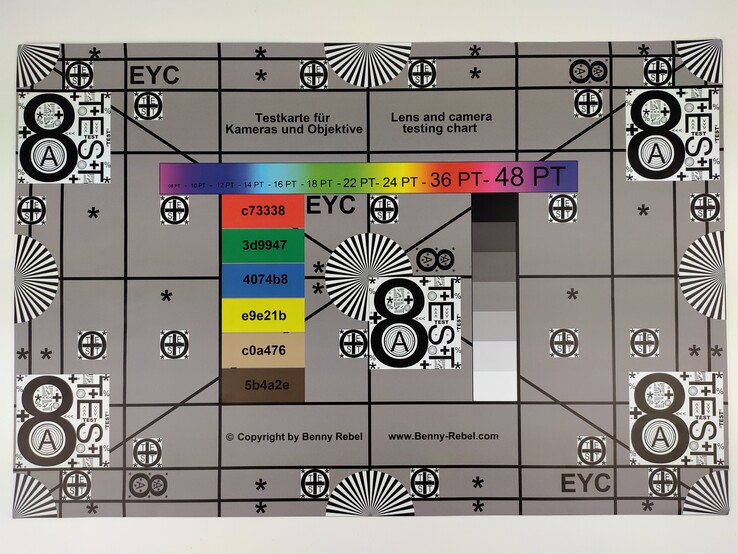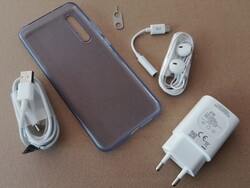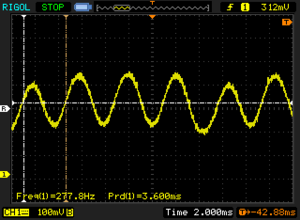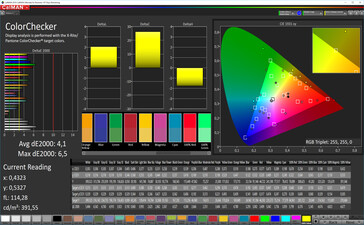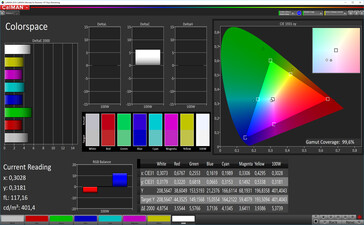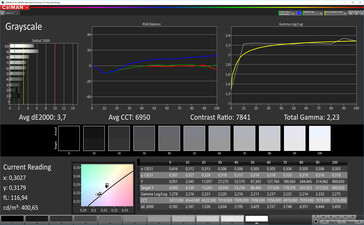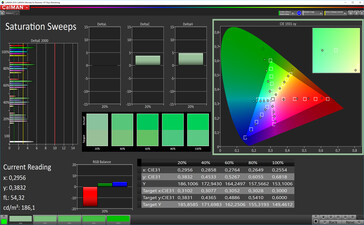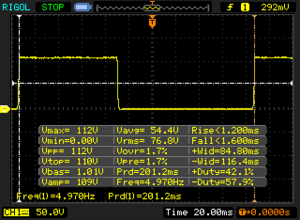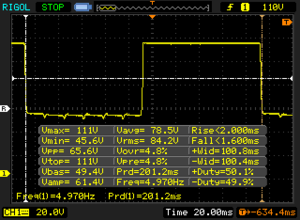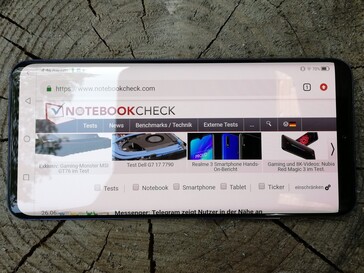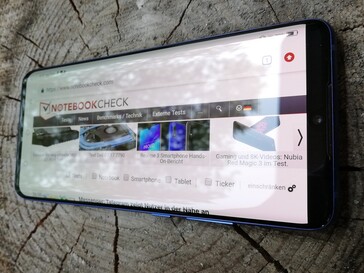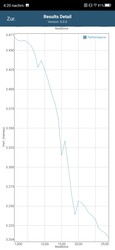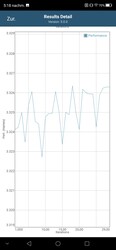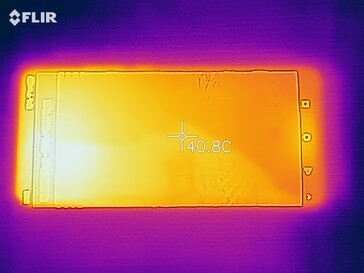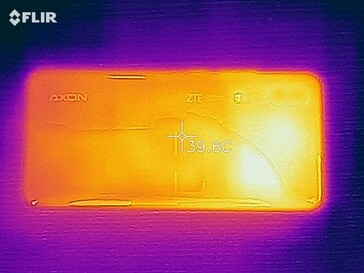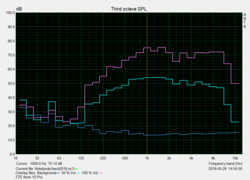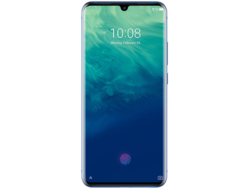ZTE Axon 10 Pro Smartphone Review: The flagship killer from China
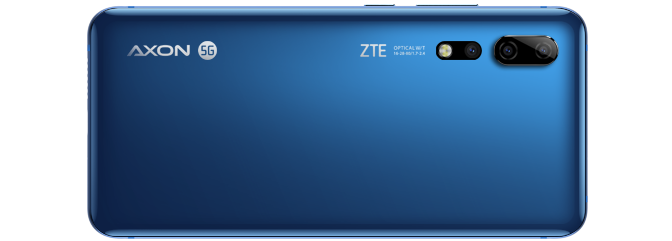
ZTE celebrated its re-entry into the smartphone market last year with the Axon 9 Pro, a device that scored 89% overall in our review. The device impressed us with its bright AMOLED panel, fast Wi-Fi, good system performance and IP68 certification. Now the company is back with the Axon 10 Pro, which takes a few steps forward while also seemingly taking a few back. Inexplicably, IP54 certification has replaced IP68, while ZTE has opted for a noticeably dimmer display.
The Axon 10 Pro comes with the more powerful Qualcomm Snapdragon 855 SoC though and a larger display. The device retains the 6 GB of RAM and 128 GB of UFS flash storage of its predecessor, along with its 4,000 mAh battery. ZTE has developed a 5G version of the Axon 10 Pro too, although this has not been released worldwide at the time of writing.
The Axon 10 Pro currently retails for around 600 Euros (~US$677), which puts it in contention with the likes of the Nokia 9 PureView, OnePlus 7, Samsung Galaxy S10e and Xiaomi Mi 9. We shall use these four as comparison devices for this review, but you can add other devices to our comparison tables should you wish.
Case
The Axon 10 Pro is a metal and glass sandwich like most modern flagships. Its display has curved edges too, another trope of contemporary flagship design. This makes the metal frame thinner at the corners than near the hardware buttons or at the top and bottom of the device. The glass back has a mirrored finish, with most light distorting its blue colour. It is a fingerprint magnet too, although you will not find yourself groping the back glass in vain for a fingerprint scanner as ZTE has equipped the device with an in-screen solution instead. The glass is broken up by the vertically arranged triple rear-facing cameras and LED flash, along with some regulatory information and branding. ZTE has placed the two hardware buttons on the right-hand side of the frame, while the bottom hosts the speaker, USB Type-C port and card slot.
Our review unit is well made, with there being no uneven gaps or structural weaknesses. The Axon 10 Pro is IP54-certified too, meaning that it is protected from dust and can withstand water splashes. This is much weaker protection against the ingress of dust and liquids than IP68 is though.
The Axon 10 Pro is comparatively long on account of its 6.47-inch display, but it is just as thin as our comparison devices at 7.9 mm. The device is rather narrow too but is heavier than all but the OnePlus 7 and its predecessor in our comparison table.
Connectivity
As we shall cover in the Performance section of this review, ZTE equips the Axon 10 Pro with a Qualcomm Snapdragon 855 SoC that integrates a Qualcomm Adreno 640 GPU, 6 GB of RAM and 128 GB of UFS 2.1 flash storage. The latter can be complemented with up to 2-TB microSD cards should you need more storage, with the Axon 10 Pro able to read all modern file systems including exFAT. The device is dual-SIM too, although it only has two card slots, with the second doubling as a microSD card slot too. This hybrid slot forces people to choose between dual-SIM functionality and microSD card expansion, of which we are not fans. Both card slots support voice over LTE (VoLTE) and voice over Wi-Fi (VoWiFi), although your network carrier must provision the Axon 10 Pro before either functionality will work.
The Axon 10 Pro also has a USB 2.0 Type-C port, which can be used for audio, charging and data. The device has no headphone jack, but ZTE includes a corresponding Type-C adapter should you wish to use traditional headphones. Better still, the Axon 10 Pro is Widevine L1-certified, meaning that it can stream DRM-protected content from services like Amazon Prime and Netflix. The device supports Camera2 API Level3 too.
Software
The Axon 10 Pro currently ships with Android 9.0 Pie, while ZTE had rolled out the April 1, 2019 set of security patches to our review unit by June. The OS comes with no third-party apps preinstalled, while ZTE allows you to uninstall in-house apps like BestWeather and Superb Cleaner. Unfortunately, some apps like ZTE Cares and Phone Switch can only be deactivated, which removes them from the app drawer.
You can save apps and data to microSD cards, although these must first be formatted as internal storage. The OS supports multiple user accounts too.
Communication & GPS
ZTE has developed 4G and 5G versions of the Axon 10 Pro, of which our review unit is the former. The device can also connect to GSM and 3G networks, while it utilises LTE Cat 20 for up to 2,000 Mb/s download speeds and 300 Mb/s upload speeds. The Axon 10 Pro also supports Bluetooth 5.0, NFC and all modern Wi-Fi standards up to IEEE 802.11ac, meaning that it can connect to 2.4 GHz or 5 GHz networks.
Our review unit performed well in our Wi-Fi tests too, which we conducted with our Linksys EA8500 reference router. The device averaged over 500 Mb/s in both iperf3 Client tests that we ran, putting it slightly behind the Axon 9 Pro and Mi 9 in our comparison tables overall.
| Networking | |
| iperf3 transmit AX12 | |
| ZTE Axon 9 Pro | |
| Xiaomi Mi 9 | |
| ZTE Axon 10 Pro | |
| Nokia 9 PureView | |
| Samsung Galaxy S10e | |
| OnePlus 7 | |
| iperf3 receive AX12 | |
| Xiaomi Mi 9 | |
| ZTE Axon 9 Pro | |
| Nokia 9 PureView | |
| ZTE Axon 10 Pro | |
| Samsung Galaxy S10e | |
| OnePlus 7 | |
| Average of class Smartphone (last 2 years) | |
The Axon 10 Pro utilises BeiDou, Galileo, GLONASS and GPS for location services, with our review unit achieving a satellite fix with up to four metres accuracy outdoors. Surprisingly, it cannot find us indoors, which is uncommon for a flagship device and akin to a lower mid-range smartphone.
The precise outdoors location accuracy followed into our bike ride where we compared our review unit’s location data against a Garmin Edge 500, our reference bike computer. The Axon 10 Pro performed well overall, especially when cornering. The device struggled to plot us on the correct side of the road during straight sections though. In short, you should have no problems with using the Axon 10 Pro for general navigation tasks like cycling, driving or walking.
Telephone Features & Call Quality
ZTE preinstalls an in-house set of telephony apps on the Axon 10 Pro. The Phone app looks and functions like the Google equivalent, with it providing direct access to a keypad and putting contacts, along with call history, in dedicated tabs. You can create contact groups too, which have a separate tab at the top of the Phone app.
Our review unit has good quality too, with the earpiece reproducing our call partner clearly. The built-in microphones do not do a great job of filtering out background noise though, so someone may struggle to hear you if you are calling from a noisy environment. The included headphones are better in this regard, with the microphone cutting out noise well.
Cameras
ZTE equips the Axon 10 Pro with triple rear-facing cameras, the main of which is a 48 MP sensor with an f/1.8 aperture. This is supported by a 20 MP wide-angle sensor with a 120° field of view (FOV) and an f/2.2 aperture. There is also an 8 MP telephoto lens that has an f/2.4 aperture. ZTE has included a 20 MP front-facing sensor too that has an f/2.0 aperture. The latter takes decent-looking selfies, although fine structures and details are slightly blurred upon looking closely. The sensor overexposes focussed objects too while making colours look more washed-out than they should be.
The default camera app contains a brightness slider and various beautification modes should you wish to tinker with your selfies. The latter allows you to soften skin by varying degrees. There are also several colour filters and an HDR mode. Additionally, ZTE has included a portrait mode that creates a bokeh effect, much like Apple’s Portrait mode.
The 48 MP sensor also takes good photos, with focussed objects reproduced sharply. Colours are vibrant too, but our test photos suffer from harsh image noise upon looking closely. Moreover, the sensor struggles to demarcate between bright and dark areas, with the latter looking woefully underexposed.
By contrast, macro photos are surprisingly detailed, while colours and the edges of objects are separated well. Again, objects outside of the focussed area are distorted by image noise when we look closely. Our review unit does a good job in low-light conditions though, as demonstrated by scene 3. Only the corners of the image are underexposed. Colours look darker than they should though, but at least objects are demarcated from the background well.
The default camera app has additional settings for the rear-facing cameras, with ZTE including a manual mode. Switching to this mode allows you to change ISO values, exposure levels and white balance among others. You can set a timer too. Additionally, the app has a “Super-Night” mode, while the portrait mode includes several special lighting modes.
The Axon 10 Pro can record videos in up to 4K with the H.264 codec. Incidentally, it can also record in MMS. The image quality of videos is just as good as photos, but the camera struggles to record moving objects smoothly and can only do so in good light. ZTE has included an image stabiliser though, which compensates well against minor shakes. The default camera app includes colour filters and beautification modes, but you cannot use the manual mode when recording videos. Likewise, you cannot record at high frame rates to create slow-motion effects either.
We also subjected our review unit to further camera tests under controlled lighting conditions. The 48 MP sensor reproduces colours noticeably darker than ColorChecker Passport reference colours, but it does a good job at capturing our test chart. Fine details and structures are recognisable, while colours pop from the mostly grey and black chart. Contrast levels drop off slightly in the lower corners of the image, but less so than on comparable smartphones.
The camera can also capture the chart well in low-light too, which is impressive. Fine details are still there, although they are dominated by image noise when looking closely. Colours look a little dark too, but not terribly so.
Accessories & Warranty
ZTE includes several accessories with the Axon 10 Pro. Our review unit arrived with a USB charger, a matching Type-A to Type-C cable, a silicone case, headphones and a 3.5 mm jack to Type-C adapter. The OEM includes a SIM tool, but it does not sell any other Axon 10 Pro-specific accessories.
The Axon 10 Pro comes with a 24-month limited manufacturer’s warranty. Please see our Guarantees, Return Policies & Warranties FAQ for country-specific information.
Input Devices & Operation
ZTE preinstalls Google Gboard as the default keyboard. The app works just as well as it has on previous devices that we have tested. The touchscreen also responds quickly and accurately reproduces our touches onscreen. However, the display has a highly resistive finish that makes multi-finger gestures like drag-and-drop movements difficult. The accelerometer worked fine during testing though.
The Axon 10 Pro has an in-screen fingerprint scanner, another feature popular among modern flagships. The one in our review unit is rather unreliable at recognising our registered fingerprints, to the extent that we preferred using a pattern or PIN instead. You could use your face to unlock the device instead, although the Axon 10 Pro only uses its front-facing camera to capture an image of your face, which is easy to spoof and not as secure as something like FaceID. Correspondingly, you cannot use face unlock on the Axon 10 Pro to authenticate things like banking apps and password managers.
Display
The Axon 10 Pro has a 6.47-inch AMOLED panel that operates natively at 2340x1080. The resolution is comparatively low by modern flagships standards, but the Axon 10 Pro is in good company here, with only the Nokia 9 PureView having better than a 1080p display of our comparison devices.
Our review unit achieved an average maximum luminosity of 399 cd/m² according to X-Rite i1Pro 2, which is between 7% and 61% dimmer than our comparison devices. Even the Axon 9 Pro has a brighter display than its successor. The more practical APL50 test registers a slightly better average maximum luminosity of 405 cd/m², but this is still a way off what the Nokia 9 PureView and OnePlus 7 reach. The display in our review unit can also get as dim as 2.72 cd/m², making it suitable for reading at night without straining your eyes while doing so.
AMOLED panels do not have backlights like their IPS counterparts so often use pulse-width modulation (PWM) in lieu to manipulate luminosity. While this works well, it looks like flickering to human eyes and can cause health issues like eyestrain and headaches. The panel in our review unit flickers at 277.8 Hz when set to 99% brightness and below, which is low enough to cause problems for those who are PWM sensitive.
| |||||||||||||||||||||||||
Brightness Distribution: 92 %
Center on Battery: 402 cd/m²
Contrast: ∞:1 (Black: 0 cd/m²)
ΔE Color 4.1 | 0.5-29.43 Ø5
ΔE Greyscale 3.7 | 0.57-98 Ø5.3
99.6% sRGB (Calman 2D)
Gamma: 2.23
| ZTE Axon 10 Pro AMOLED, 2340x1080, 6.47 | ZTE Axon 9 Pro AMOLED, 2248x1080, 6.21 | OnePlus 7 AMOLED, 2340x1080, 6.41 | Nokia 9 PureView P-OLED, 2880x1440, 5.99 | Xiaomi Mi 9 AMOLED, 2340x1080, 6.39 | Samsung Galaxy S10e AMOLED, 2280x1080, 5.80 | |
|---|---|---|---|---|---|---|
| Screen | 23% | 21% | 38% | 51% | 28% | |
| Brightness middle | 402 | 521 30% | 603 50% | 648 61% | 593 48% | 426 6% |
| Brightness | 399 | 517 30% | 605 52% | 641 61% | 587 47% | 427 7% |
| Brightness Distribution | 92 | 96 4% | 94 2% | 92 0% | 94 2% | 96 4% |
| Black Level * | ||||||
| Colorchecker dE 2000 * | 4.1 | 2.9 29% | 3.5 15% | 2.3 44% | 0.9 78% | 2.14 48% |
| Colorchecker dE 2000 max. * | 6.5 | 5.5 15% | 7.7 -18% | 5.2 20% | 2 69% | 3.29 49% |
| Greyscale dE 2000 * | 3.7 | 2.7 27% | 2.7 27% | 2.2 41% | 1.5 59% | 1.8 51% |
| Gamma | 2.23 99% | 2.01 109% | 2.266 97% | 2.3 96% | 2.27 97% | 2.111 104% |
| CCT | 7841 83% | 6288 103% | 6775 96% | 6592 99% | 6548 99% | 6329 103% |
* ... smaller is better
Screen Flickering / PWM (Pulse-Width Modulation)
| Screen flickering / PWM detected | 277.8 Hz | ≤ 99 % brightness setting | |
The display backlight flickers at 277.8 Hz (worst case, e.g., utilizing PWM) Flickering detected at a brightness setting of 99 % and below. There should be no flickering or PWM above this brightness setting. The frequency of 277.8 Hz is relatively high, so most users sensitive to PWM should not notice any flickering. However, there are reports that some users are still sensitive to PWM at 500 Hz and above, so be aware. In comparison: 53 % of all tested devices do not use PWM to dim the display. If PWM was detected, an average of 17903 (minimum: 5 - maximum: 3846000) Hz was measured. | |||
One advantage that AMOLED panels have over IPS ones is their ability to individually switch off pixels. This allows the Axon 10 Pro to theoretically achieve infinite contrast and black levels, making colours look more vibrant than they would on a comparable IPS panel.
CalMAN analysis shows that the display has a slight blue tint though, reducing colour accuracy. Fortunately, ZTE has included a freely adjustable colour mode within Settings should you wish to alter how the display reproduces colours. You can also choose from cold, warm and normal presets should you not fancy tweaking colour settings.
Display Response Times
| ↔ Response Time Black to White | ||
|---|---|---|
| 2.8 ms ... rise ↗ and fall ↘ combined | ↗ 1.2 ms rise | |
| ↘ 1.6 ms fall | ||
| The screen shows very fast response rates in our tests and should be very well suited for fast-paced gaming. In comparison, all tested devices range from 0.1 (minimum) to 240 (maximum) ms. » 8 % of all devices are better. This means that the measured response time is better than the average of all tested devices (21.5 ms). | ||
| ↔ Response Time 50% Grey to 80% Grey | ||
| 3.6 ms ... rise ↗ and fall ↘ combined | ↗ 2 ms rise | |
| ↘ 1.6 ms fall | ||
| The screen shows very fast response rates in our tests and should be very well suited for fast-paced gaming. In comparison, all tested devices range from 0.2 (minimum) to 636 (maximum) ms. » 9 % of all devices are better. This means that the measured response time is better than the average of all tested devices (33.7 ms). | ||
The rich contrast ratio and deep blacks help when using the Axon 10 Pro outdoors, as they help prevent the display from looking washed-out. However, its low maximum luminosity and highly reflective display mean that you will struggle to read the device in bright sunlight. Even bright artificial lights can overpower the display.
The Axon 10 Pro has stable viewing angles thanks to its AMOLED panel. We noticed no brightness distortions even at acute angles, although we noticed a slight green tint. In short, you should have no issues with reading the display from practically any angle, except when you are impeded by reflections.
Performance
ZTE has equipped the Axon 10 Pro with a Qualcomm Snapdragon 855 SoC and 6 GB of RAM, the former of which integrates a Qualcomm Adreno 640 GPU among other components. The device also has 128 GB of UFS 2.1 flash storage, which is now the current standard for modern flagships. Overall, the Axon 10 Pro should always run smoothly thanks to its powerful hardware and is on par with the likes of the Mi 9 and OnePlus 7.
Our benchmark results reinforce this, with the Axon 10 Pro generally vying for first place in our comparison tables with its Snapdragon 855-equipped competitors. Overall, the Axon 10 Pro offers about a 15-20% performance improvement in synthetic benchmarks over its predecessor, the Axon 9 Pro.
| AnTuTu v7 - Total Score (sort by value) | |
| ZTE Axon 10 Pro | |
| ZTE Axon 9 Pro | |
| OnePlus 7 | |
| Nokia 9 PureView | |
| Xiaomi Mi 9 | |
| Samsung Galaxy S10e | |
| Average Qualcomm Snapdragon 855 (217967 - 398720, n=16) | |
Again, our review unit performed well in browser benchmarks, with it achieving results comparable to the Mi 9 and OnePlus 7. The Axon 10 Pro finished top in two of our five browser benchmarks too.
The performance in browser benchmarks reflects our impression of using the Axon 10 Pro in daily life. The preinstalled Google Chrome browser runs smoothly, with websites and media content loading quickly.
| Jetstream 2 - Total Score | |
| Average of class Smartphone (13.8 - 351, n=173, last 2 years) | |
| OnePlus 7 (Chrome 74) | |
| Average Qualcomm Snapdragon 855 (45.5 - 67, n=16) | |
| Xiaomi Mi 9 (Chrome 73) | |
| ZTE Axon 10 Pro (Chrome 74) | |
| Nokia 9 PureView (Chrome 73.0.3683.90) | |
| Speedometer 2.0 - Result | |
| Average of class Smartphone (14.9 - 445, n=157, last 2 years) | |
| OnePlus 7 (Chome 74) | |
| ZTE Axon 10 Pro (Chrome 74) | |
| Xiaomi Mi 9 (Chrome 73.0.3683.75) | |
| Average Qualcomm Snapdragon 855 (42.5 - 67.9, n=15) | |
| Nokia 9 PureView (Chrome 73.0.3683.90) | |
| WebXPRT 3 - Overall | |
| Average of class Smartphone (39 - 304, n=122, last 2 years) | |
| OnePlus 7 (Chrome 74) | |
| Xiaomi Mi 9 (Chrome 73.0.3683.75) | |
| Average Qualcomm Snapdragon 855 (90 - 129, n=20) | |
| ZTE Axon 10 Pro (Chrome 74) | |
| Nokia 9 PureView (Chrome 73.0.3683.90) | |
| Octane V2 - Total Score | |
| Average of class Smartphone (2228 - 89112, n=214, last 2 years) | |
| ZTE Axon 10 Pro (Chrome 74) | |
| OnePlus 7 (Chrome 74) | |
| Xiaomi Mi 9 (Chrome 73.0.3683.75) | |
| Average Qualcomm Snapdragon 855 (17011 - 33918, n=21) | |
| Samsung Galaxy S10e (Chrome 73) | |
| Nokia 9 PureView (Chrome 73.0.3683.90) | |
| ZTE Axon 9 Pro (Chrome 71) | |
| Mozilla Kraken 1.1 - Total | |
| Nokia 9 PureView (Chrome 73.0.3683.90) | |
| ZTE Axon 9 Pro (Chrome 71) | |
| Samsung Galaxy S10e (Chrome 73) | |
| Average Qualcomm Snapdragon 855 (1852 - 2611, n=19) | |
| OnePlus 7 (Chrome 74) | |
| Xiaomi Mi 9 (Chrome 73.0.3683.75) | |
| ZTE Axon 10 Pro (Chrome 74) | |
| Average of class Smartphone (388 - 9999, n=173, last 2 years) | |
* ... smaller is better
As mentioned earlier, ZTE has equipped the Axon 10 Pro with 128 GB of UFS 2.1 storage, of which approximately 113 GB is free upon first booting the device. Our review unit has excellent transfer speeds and finished top of our AndroBench comparison table alongside the OnePlus 7.
One major advantage that the Axon 10 Pro has over its contemporaries is microSD card expansion. Only the Axon 9 Pro and Galaxy S10e also have microSD card readers of our comparison devices. Many other modern flagships lack expandable storage too, like the Google Pixel 3 XL and the iPhone XS Max. Our review unit achieved decent transfer speeds with our Toshiba Exceria Pro M501 reference cards. Overall, the Axon 10 Pro performed marginally better than its predecessor and the Galaxy S10e.
| ZTE Axon 10 Pro | ZTE Axon 9 Pro | OnePlus 7 | Nokia 9 PureView | Xiaomi Mi 9 | Samsung Galaxy S10e | Average 128 GB UFS 2.1 Flash | Average of class Smartphone | |
|---|---|---|---|---|---|---|---|---|
| AndroBench 3-5 | -29% | 0% | -42% | -13% | -30% | -16% | 82% | |
| Sequential Read 256KB | 769 | 719 -7% | 1463 90% | 728 -5% | 666 -13% | 792 3% | 760 ? -1% | 1508 ? 96% |
| Sequential Write 256KB | 503 | 196.4 -61% | 392 -22% | 200.3 -60% | 388.3 -23% | 194.1 -61% | 297 ? -41% | 1118 ? 122% |
| Random Read 4KB | 150.4 | 141.3 -6% | 175.3 17% | 132 -12% | 149.4 -1% | 136.9 -9% | 152.9 ? 2% | 247 ? 64% |
| Random Write 4KB | 189.5 | 22.52 -88% | 28.7 -85% | 20.18 -89% | 165.3 -13% | 24.1 -87% | 131.6 ? -31% | 272 ? 44% |
| Sequential Read 256KB SDCard | 88.2 ? | 85.4 ? -3% | 73.2 ? -17% | 76 ? -14% | ||||
| Sequential Write 256KB SDCard | 66.8 ? | 61.6 ? -8% | 60.7 ? -9% | 59.6 ? -11% |
Games
The Adreno 640 succeeds the Adreno 630 and offers about 20% better performance than its predecessor. In short, the Axon 10 Pro should cope with any mobile game that you throw at it. Our review unit averaged just over 59 FPS in Arena of Valor and Shadow Fight 3 regardless of the graphics settings at which we played, underlining that the Axon 10 Pro has more performance in reserve.
The touchscreen and associated sensors worked perfectly during our gaming tests too. The display has a highly resistive finish though, which may make long gaming sessions feel like a chore.
Arena of Valor
Shadow Fight 3
Emissions
Temperature
The Axon 10 Pro manages its surface temperatures well when idling, but it gets too hot for our liking under sustained load. Our review unit averaged just over 27 °C at idle, with two areas reaching but not exceeding 28 °C. Oddly, the hottest areas at idle are the coolest under load. About 50% of the device reaches just over 40 °C under sustained load, with one area peaking at a toasty 41.4 °C. In short, the Axon 10 Pro may feel uncomfortable to hold if you are gaming for a prolonged period.
We also subjected our review unit to a series of GFXBench benchmarks to see how it managed its performance under sustained load. The device had no problems in the T-Rex benchmark, with it maintaining consistent frame rates throughout our loop of 30 benchmark run-throughs. However, we measured an 8% performance drop in the more complex Manhattan test, but this is not a terrible result. Overall, you should experience no thermal throttling in daily use.
(±) The maximum temperature on the upper side is 41.4 °C / 107 F, compared to the average of 35 °C / 95 F, ranging from 21.9 to 56 °C for the class Smartphone.
(±) The bottom heats up to a maximum of 40.9 °C / 106 F, compared to the average of 33.8 °C / 93 F
(+) In idle usage, the average temperature for the upper side is 27.5 °C / 82 F, compared to the device average of 32.7 °C / 91 F.
Speakers
ZTE has equipped the Axon 10 Pro with stereo speakers, which get comparatively loud and deliver a wide sound spectrum. The ones in our review unit reached a maximum of 83.6 dB(A) during our tests, and while music sounds full-bodied, bass and high frequencies are underrepresented. We would always recommend using external audio equipment like headphones and speakers instead of smartphone speakers, but the ones in the Axon 10 Pro are good enough for watching the occasional YouTube video or playing the odd song.
ZTE has gone the way of many OEMs and failed to include a 3.5 mm headphone jack in the Axon 10 Pro, but it has at least included a corresponding Type-C adapter in the box. Carrying around a dongle may prove impractical in daily use, but the one included with our review unit does not compromise audio quality, with headphones sounding just as good as if they were plugged directly into a headphone jack. Alternatively, you could use Bluetooth, with the Axon 10 Pro supporting the 5.0 standard.
ZTE Axon 10 Pro audio analysis
(+) | speakers can play relatively loud (83.6 dB)
Bass 100 - 315 Hz
(-) | nearly no bass - on average 22.4% lower than median
(±) | linearity of bass is average (12.1% delta to prev. frequency)
Mids 400 - 2000 Hz
(+) | balanced mids - only 4.4% away from median
(+) | mids are linear (5.3% delta to prev. frequency)
Highs 2 - 16 kHz
(+) | balanced highs - only 3.1% away from median
(+) | highs are linear (5.4% delta to prev. frequency)
Overall 100 - 16.000 Hz
(±) | linearity of overall sound is average (17.8% difference to median)
Compared to same class
» 10% of all tested devices in this class were better, 7% similar, 83% worse
» The best had a delta of 12%, average was 38%, worst was 134%
Compared to all devices tested
» 31% of all tested devices were better, 8% similar, 61% worse
» The best had a delta of 4%, average was 25%, worst was 134%
Xiaomi Mi 9 audio analysis
(+) | speakers can play relatively loud (87.1 dB)
Bass 100 - 315 Hz
(-) | nearly no bass - on average 25.1% lower than median
(±) | linearity of bass is average (10.7% delta to prev. frequency)
Mids 400 - 2000 Hz
(+) | balanced mids - only 4.4% away from median
(+) | mids are linear (5% delta to prev. frequency)
Highs 2 - 16 kHz
(+) | balanced highs - only 3.4% away from median
(+) | highs are linear (4% delta to prev. frequency)
Overall 100 - 16.000 Hz
(±) | linearity of overall sound is average (17.3% difference to median)
Compared to same class
» 8% of all tested devices in this class were better, 6% similar, 86% worse
» The best had a delta of 12%, average was 38%, worst was 134%
Compared to all devices tested
» 27% of all tested devices were better, 8% similar, 65% worse
» The best had a delta of 4%, average was 25%, worst was 134%
Power Management
Power Consumption
Our tests certify that the Axon 10 Pro is a comparatively energy-efficient smartphone. Our review unit consumes a minimum of 0.76 W at idle, which is unremarkable. However, it consumes a maximum of just 1.18 W when idling and averaged 3.95 W under load, making it economic by Snapdragon 855 standards. Its maximum consumption under load is also less than all but the Nokia 9 PureView of our comparison devices.
ZTE includes an 18 W quick charger in the box. Hence, the charger is powerful enough to keep the Axon 10 Pro charging even when it is being pushed to its limits.
| Off / Standby | |
| Idle | |
| Load |
|
| ZTE Axon 10 Pro 4000 mAh | ZTE Axon 9 Pro 4000 mAh | OnePlus 7 3700 mAh | Nokia 9 PureView 3320 mAh | Xiaomi Mi 9 3300 mAh | Samsung Galaxy S10e 3100 mAh | Average Qualcomm Snapdragon 855 | Average of class Smartphone | |
|---|---|---|---|---|---|---|---|---|
| Power Consumption | -17% | -10% | -68% | -5% | -16% | -29% | -27% | |
| Idle Minimum * | 0.76 | 0.86 -13% | 0.6 21% | 1.65 -117% | 0.67 12% | 0.6 21% | 0.939 ? -24% | 0.897 ? -18% |
| Idle Average * | 1.15 | 1.1 4% | 1.1 4% | 2.34 -103% | 1.26 -10% | 1.2 -4% | 1.506 ? -31% | 1.452 ? -26% |
| Idle Maximum * | 1.18 | 1.21 -3% | 2 -69% | 2.43 -106% | 1.29 -9% | 1.5 -27% | 1.799 ? -52% | 1.629 ? -38% |
| Load Average * | 3.95 | 5.02 -27% | 4 -1% | 5.02 -27% | 3.71 6% | 5.2 -32% | 4.61 ? -17% | 5.55 ? -41% |
| Load Maximum * | 7.49 | 10.82 -44% | 8 -7% | 6.51 13% | 9.3 -24% | 10.2 -36% | 9.04 ? -21% | 8.31 ? -11% |
* ... smaller is better
Battery Life
The Axon 10 Pro has a 4,000 mAh battery, a capacity on par with its predecessor and one that is larger than all the batteries in our comparison devices.
With that said, the Axon 10 Pro finished second to the OnePlus 7 in our Wi-Fi battery life test with a runtime of 11:20 hours. The Axon 10 Pro needed recharging 3:41 hours sooner than the OnePlus 7, although the latter is an outlier here. This is only 19 minutes longer than the Axon 9 Pro too, but it is well ahead of our other comparison devices.
The bundled charger supports QuickCharge 4.0 and fully recharges the Axon 10 Pro in just over two hours. You can also re-charge the device with any Qi-standard wireless charger.
| ZTE Axon 10 Pro 4000 mAh | ZTE Axon 9 Pro 4000 mAh | OnePlus 7 3700 mAh | Nokia 9 PureView 3320 mAh | Xiaomi Mi 9 3300 mAh | Samsung Galaxy S10e 3100 mAh | |
|---|---|---|---|---|---|---|
| Battery Runtime | -3% | 13% | -26% | -13% | -32% | |
| Reader / Idle | 1927 | 1989 3% | 1250 -35% | 1650 -14% | 1185 -39% | |
| H.264 | 1068 | 933 -13% | 732 -31% | 1008 -6% | 795 -26% | |
| WiFi v1.3 | 680 | 661 -3% | 901 33% | 486 -29% | 546 -20% | 416 -39% |
| Load | 217 | 278 28% | 202 -7% | 194 -11% | 164 -24% |
Pros
Cons
Verdict
The ZTE Axon 10 Pro can compete with more-expensive flagships on many levels. It has excellent system performance thanks to its Qualcomm Snapdragon 855 SoC and 6 GB of RAM. Many OEMs omit microSD card expansion at this price too, which gives the Axon 10 Pro an edge as it can read up to 2-TB cards. The device has good quality cameras too, especially for taking macro photos. However, ZTE does not do the Axon 10 Pro any favours by designing it look almost indistinguishable from the Huawei P30 Pro.
The ZTE Axon 10 Pro is a powerful alternative to other more-expensive flagships. However, it does not do enough to differentiate itself from the competition in our opinion. Worse still, it looks like a copycat.
The device suffers from some irritating shortfalls too. While we like its AMOLED panel for its good contrast ratio and black value, it is comparatively dark by flagship smartphone standards. Moreover, our review unit gets too warm for our liking under sustained load and may feel uncomfortable to some people when gaming.
Overall, the Axon 10 Pro is a well-equipped and potent foil to more-established flagship series. ZTE has included NFC, wireless charging and fast Wi-Fi, all of which are welcome. The company has even developed a 5G variant, although the 4G model remains the better value considering the limited roll-out of 5G at the time of writing.
ZTE Axon 10 Pro
-
08/31/2022 v7
Mike Wobker


 Deutsch
Deutsch English
English Español
Español Français
Français Italiano
Italiano Nederlands
Nederlands Polski
Polski Português
Português Русский
Русский Türkçe
Türkçe Svenska
Svenska Chinese
Chinese Magyar
Magyar